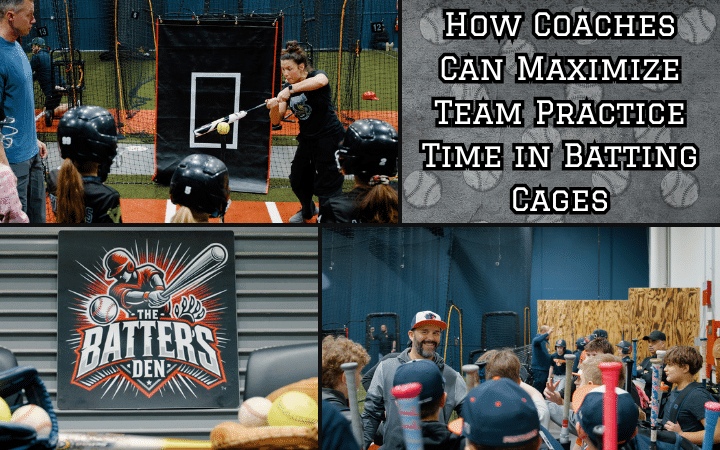
Effective cage time doesn’t just happen; it’s planned, organized, and executed with purpose. Our mantra, “With repetition comes results,” is especially true here, but it’s about quality repetition.
Planning Makes Perfect, Before You Even Arrive
The most productive cage sessions start long before your team steps into the facility.
- Have a Written Plan: Don’t just wing it! Outline specific drills, station rotations, time allocations for each activity, and the goals for the session. A clear blueprint keeps everyone on track.
- Communicate the Plan: Give your players (and any assistant coaches) a heads-up about the schedule and what’s expected. When players know the “why” and “what,” they’re more engaged.
- Set Skill-Specific Goals: What do you want to achieve today? Is it better two-strike hitting? Opposite-field power? Focusing on 1-2 key skills per session yields better results than trying to cover everything.
- Group Players Strategically: Consider grouping players by skill level, age, or specific needs for certain drills. This allows for more targeted instruction and appropriate challenges.
- Equipment Check: Ensure all bats, helmets, practice balls, tees, L-screens, and any other necessary equipment are organized and ready to go. Scrambling for gear eats up valuable time.
Making Every Minute Count During the Cage Session
Once you’re in the cages, it’s all about efficiency and engagement.
- Station-Based Training is Your Best Friend: This is where having multiple cages, like we do at The Batter’s Den, really pays off!
- Example Setup (3 cages):
- Cage 1: Live pitching (coach pitch or machine) focusing on timing and game-like swings.
- Cage 2: Tee work drills targeting specific mechanics (e.g., bat path, hip rotation).
- Cage 3: Soft toss or front toss focusing on hand-eye coordination and consistent contact.
- Consider stations outside the cages too (if space and safety permit) for things like bunting practice, defensive footwork drills, or strength/conditioning exercises.
- Example Setup (3 cages):
- Keep Players Moving & Engaged: Design your stations and rotations to minimize downtime. If a player isn’t hitting, they should be actively involved in another drill, shagging, or preparing for their next set.
- Incorporate Variety: Mix up drills to keep players mentally fresh and to work on different aspects of hitting. Think beyond just round after round of batting practice:
- Situational hitting (runner on third, less than two outs).
- Hitting to specific fields.
- Two-strike approach drills.
- Practice Quick Transitions: Teach your players to move efficiently between drills and stations. A few wasted minutes between each rotation add up quickly!
- Leverage Your Support Staff: If you have assistant coaches or trusted parent volunteers, assign them specific stations or responsibilities. This allows for more individualized attention.
- Focus on Quality Reps, Not Just Sheer Quantity: Remind players that every swing has a purpose. Mindless hacking reinforces bad habits. Encourage them to focus on their mechanics and make adjustments.
- Simulate Game Conditions: Where possible, add elements that mimic game pressure. Use counts, call out scenarios, or even introduce friendly intra-squad competitions.
- Provide Concise, Actionable Feedback: Avoid long lectures. Offer quick, targeted tips that players can immediately apply.
Common Pitfalls to Avoid
Even the best intentions can go awry. Here are some common traps and how to avoid them:
Pitfall 1: Too Much Standing Around.
- The Problem: Players get bored, cold, and disengaged.
- Avoidance: Implement dynamic station work with small groups per station. Ensure everyone has a role or is actively preparing for their next turn.
Pitfall 2: One-Size-Fits-All Drills.
- The Problem: Advanced players aren’t challenged, and developing players get frustrated or overwhelmed.
- Avoidance: When possible, differentiate drills. For example, use different tee heights, pitch speeds, or drill complexities based on skill groups.
Pitfall 3: No Clear Objectives for the Session.
- The Problem: Practice feels random, and progress is hard to measure.
- Avoidance: Stick to your pre-practice plan! Remind yourself and the players of the specific goals for that day.
Pitfall 4: Overloading with Instruction (“Paralysis by Analysis”).
- The Problem: Players get confused trying to think about too many mechanical changes at once.
- Avoidance: Focus on 1-2 key teaching points per drill or for a particular player during that session. Keep feedback short and sweet.
Pitfall 5: Forgetting the “Why.”
- The Problem: Players may just go through the motions if they don’t understand a drill’s purpose.
- Avoidance: Briefly explain the benefit of each drill. “We’re doing this tee drill to work on staying inside the ball, which will help you hit line drives up the middle.”
Pitfall 6: Not Utilizing All Available Resources.
- The Problem: Valuable cage space or training tools go unused.
- Avoidance: If you have access to multiple cages, plan to use them all effectively with well-designed stations. Use tees, soft toss machines, and different types of practice balls.
Pitfall 7: Practice Drags or Becomes Monotonous.
- The Problem: Energy drops, focus wanes, and learning slows.
- Avoidance: Keep the pace brisk. Inject energy with your coaching style. Introduce competitive elements (e.g., points for quality hits) and vary drills to maintain interest.
Post-Practice Power-Up
Don’t just pack up and leave. Take a few minutes to:
- Quick Review: Briefly discuss what went well and what still needs work.
- Reinforce Positives: Acknowledge effort and improvements.
- Look Ahead: Briefly touch on what the focus might be for the next session.
Make Every Swing Count!
Coaches, effectively utilizing your batting cage time can be a massive game-changer for your team’s offensive development. By planning meticulously, keeping players engaged with dynamic station-based work, and avoiding common pitfalls, you’ll create a productive environment where skills sharpen and confidence soars.
Here at The Batter’s Den, we’re passionate about providing teams like yours with the perfect indoor batting cages and training facility to put these strategies into action. We believe in your players, and we believe in the power of dedicated, smart practice. Now go out there and make every swing count!

